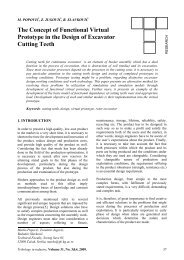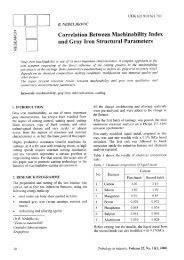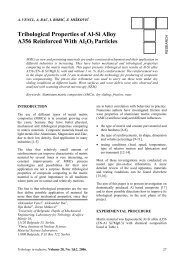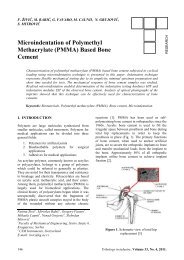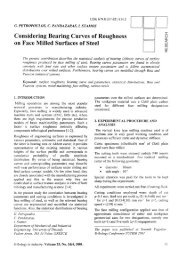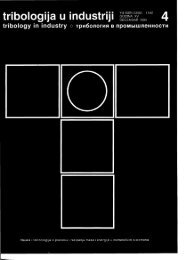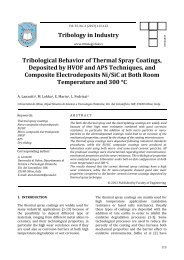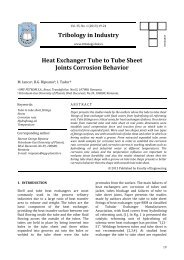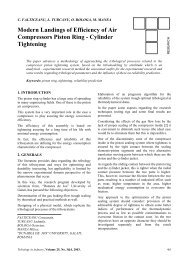No. 4, 1998 - Tribology in Industry
No. 4, 1998 - Tribology in Industry
No. 4, 1998 - Tribology in Industry
Create successful ePaper yourself
Turn your PDF publications into a flip-book with our unique Google optimized e-Paper software.
The end of this century, i.e., the n<strong>in</strong>eties, is the period of<br />
globalization <strong>in</strong> all the aspects of lubrication technology<br />
(technologry of lubricants manufactur<strong>in</strong>g, t est<strong>in</strong>g, standardization,<br />
aoplication, ecolory), through the activities<br />
of many <strong>in</strong>ternationai organizations founded <strong>in</strong> Europe,<br />
America and Asia. These activities are primarily aimed<br />
at:<br />
. lower<strong>in</strong>g the system costs and<br />
. environmental protection.<br />
Lnwer costs <strong>in</strong> systems where lubricants are applied can<br />
be achieved by:<br />
. extend<strong>in</strong>g the <strong>in</strong>terval of lubrication application<br />
. lower ma<strong>in</strong>tenance costs durlng the whole mach<strong>in</strong>e<br />
lifetime. and<br />
. application of ior-life lubricants.<br />
The use of ecoiogically acceptable lubricants, the so-called<br />
"green" lubricants, is also an imperative. Ecological<br />
problems can be solved by:<br />
. improv<strong>in</strong>g the applied lubricants efficiency<br />
. decreas<strong>in</strong>g and/or elim<strong>in</strong>ation of emission, and<br />
. apolication of rapidly biodegradable lubricants.<br />
It follows that the basis for characterization of future<br />
lubricants is go<strong>in</strong>g to be a comb<strong>in</strong>ation of economic and<br />
ecological factors.<br />
3. LUBRICANTS FOR TRANSPORTA'TION<br />
MEANS AND MECruTNIZATION<br />
Basic types of lubricants that are applied <strong>in</strong> transportation<br />
and mechanization are eng<strong>in</strong>e oils, gear oils and<br />
lubricat<strong>in</strong>greases. Out of the lubricants mentioned here<br />
the dom<strong>in</strong>ant ones accord<strong>in</strong>g to application are eng<strong>in</strong>e<br />
oils with about BSVo, while the consumption of gear oils<br />
amounts to cra l3Vo, and lubricat<strong>in</strong>g greases 2 to 3Vo.It<br />
should be kept <strong>in</strong> m<strong>in</strong>d that transportation consumes<br />
over 507o of the total quantity of lubricants [6, 7]. These<br />
data expla<strong>in</strong> why eng<strong>in</strong>e oils and gear oils are <strong>in</strong> the focus<br />
of <strong>in</strong>terest of both lubricants manufacturers and consumers.<br />
Hydrocracked oils, whose production was realized a few<br />
years back, erhibit certa<strong>in</strong> advantages with respect to<br />
parraf<strong>in</strong>ic solvent raff<strong>in</strong>ants Cfub 1).<br />
Table L Properties ofhydro-crackedbase oib<br />
n(/-l nu-tl HC-lll<br />
Vscosity<br />
<strong>in</strong>dex 1O0<br />
Chemicailv clean<br />
S/ithout suitur<br />
lncreased thermal<br />
stabilitv<br />
Volatility (<strong>No</strong>ack)<br />
similar to SN<br />
Manufactur<strong>in</strong>g<br />
costs similar to<br />
SN<br />
Viscosity<br />
<strong>in</strong>dex 130<br />
Chemicailv clean<br />
Without sultur<br />
Increased<br />
thermal stabilitv<br />
Volatility (<strong>No</strong>ack)<br />
decreased<br />
Manufactur<strong>in</strong>g<br />
costs significantly<br />
lower than for<br />
PAO<br />
Viscosity<br />
<strong>in</strong>dex 145<br />
Chemicallv clean<br />
Without sultur<br />
Increased<br />
thermal stabilitv<br />
Volatility (<strong>No</strong>ack)<br />
decreased<br />
Manufactur<strong>in</strong>g<br />
costs lower than<br />
for PAO<br />
New technologr offers base oils of such quality that can<br />
satisfy present-day specifications. In their properties hydrocracked<br />
oils surpass typical solvent raff<strong>in</strong>ants, especially<br />
<strong>in</strong> applications where thermal and oxidation stability<br />
is important. In literature, these base oils are frequently<br />
called pure base oils (PBO) or unconventional hydrocarbon<br />
base oils (UHBO).<br />
Generally, base oiis used for manufactur<strong>in</strong>g modern eng<strong>in</strong>e<br />
oils, ought to provide for [B]:<br />
. fuel efficiency (lubricants rheology)<br />
. low emission (low volatility ai low visccrsify)<br />
. extended oil dra<strong>in</strong> <strong>in</strong>tewals (chemical purity).<br />
Decrease of fuel consumptiorr <strong>in</strong> eng<strong>in</strong>es (better fuel<br />
efticiency) can be achieved by lower<strong>in</strong>g friction, which <strong>in</strong><br />
ihe case of eng<strong>in</strong>e oils nreans apply<strong>in</strong>g low viscosity base<br />
oils. Due to this, the use of monograde oils <strong>in</strong> Diesel<br />
eng<strong>in</strong>es is becom<strong>in</strong>g ever smaller,while <strong>in</strong> multigrade oils<br />
there is a tendency to change from grade 15w-x to 10w-x.<br />
As regards petrol eng<strong>in</strong>es, oils with grade 5w-x are already<br />
to be found on the market.<br />
Lowvolatilityof thebase oil results <strong>in</strong> Ioweroil consumption<br />
and <strong>in</strong> lower emission, which is significant <strong>in</strong> Diesel<br />
3.1.Eng<strong>in</strong>e oils<br />
Development of new eng<strong>in</strong>es requires new high quality<br />
lubricants of precisely def<strong>in</strong>ed properties. Also, consumers<br />
today damand higher performances from lubricants,<br />
s<strong>in</strong>ce they are striv<strong>in</strong>g for lower qystem costs and<br />
higher efficiency of the equipment. Manufactur<strong>in</strong>g of<br />
such lubricants makes necessary the improvement of the<br />
characteristics of both base oils and additives.<br />
The future belongs to the family of base oils that <strong>in</strong>cludes:<br />
hydrocracked oils (FIC), polyalphaolef<strong>in</strong>s (PAO)<br />
and rapidly biodegradablesters.<br />
ni<br />
q)<br />
c<br />
(U<br />
'x<br />
o<br />
o<br />
I<br />
o<br />
:<br />
6n<br />
40<br />
JU<br />
20<br />
IU<br />
Figurc 1. Differences <strong>in</strong> evaporatiott belnvior<br />
of base oils (<strong>No</strong>ack test)<br />
138<br />
Tibologt itt <strong>in</strong>dwtry, Volume 20, <strong>No</strong>. 4rLggl.



